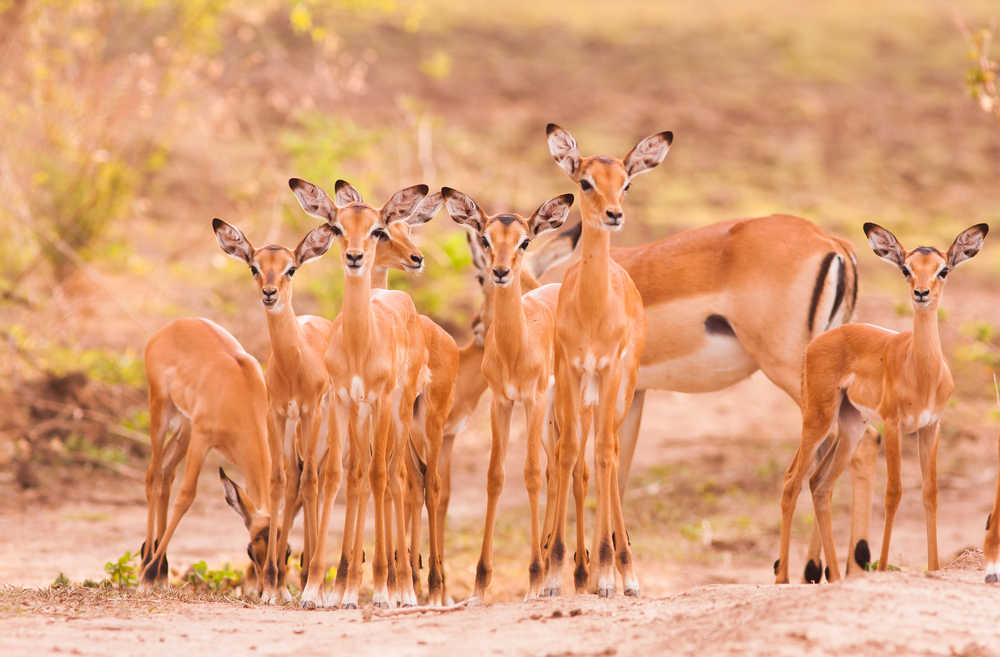Facts About Impalas

Impalas are medium-sized antelopes that look like a mix between a goat and a deer. They have long legs and necks and black, twisted horns. As members of the Bovidae family, they are related to goats, cattle and sheep.
Size
Impalas weigh around the same amount as a large dog at 88 to 165 lbs. (40 to 75 kilograms). They grow to 33 to 39 inches (84 to 99 centimeters) long by adulthood and typically come up to the chest of an average-sized adult man, according to National Geographic. The male’s horns grow to 18 to 37 inches (46 to 94 cm) long.
Habitat
The impala is native to Africa, and ranges from Angola, Namibia to northeast South Africa and north through Botswana, Zimbabwe, Mozambique, Zambia, Tanzania and Kenya. It lives in woodlands with little undergrowth and low to medium high grassland, according to the University of Michigan's Animal Diversity Web (ADW). They also live in savannas.
Habits
Impala are diurnal, which means they are most active in the early morning and right before sunset. During the rainy season, impalas gather in groups of hundreds. In dry season the herds roam together to look for food. During the rainy season males can be territorial and will herd females around a territorial area.
Groups of young impalas are called creches. These groups of offspring are like nursery schools for the young and they play together and groom each other, according to ADW.
Diet
Impalas are herbivores, which means they only eat vegetation. Their diets consist of bark, leaves, wood, and stems.
Offspring
Before giving birth, a female will leave the herd. After a gestation period of six to seven months, she will give birth, usually to only one offspring at a time. Baby impalas are called calves. After a day or two, the mother impala will bring her calf back to the herd.
Get the world’s most fascinating discoveries delivered straight to your inbox.
Calves are weaned at four to seven months, and at 12 to 18 months, the calf is mature enough to have its own offspring. Impalas usually live to around 13 years in the wild.
Classification/taxonomy
Here is the taxonomy of impalas, according to the Integrated Taxonomic Information System (ITIS):
Kingdom: Animalia Subkingdom: Bilateria Infrakingdom: Deuterostomia Phylum: Chordata Subphylum: Vertebrata Infraphylum: Gnathostomata Superclass: Tetrapoda Class: Mammalia Subclass: Theria Infraclass: Eutheria Order: Artiodactyla Family: Bovidae Subfamily: Aepycerotinae Genus & species: Aepyceros melampus Subspecies:
- Aepyceros melampus johnstoni (Malawi impala)
- Aepyceros melampus katangae (Katangan impala)
- Aepyceros melampus melampus (Common impala, or black-faced impala)
- Aepyceros melampus petersi (Angolan impala)
- Aepyceros melampus rendilis (Kenyan impala)
- Aepyceros melampus suara (Tanzanian impala)
Conservation status
According to the International Union for Conservation of Nature (IUCN), impalas are not endangered. Currently, the population is estimated at almost 2 million. Fifty percent of the population is found on private land and another 25 percent of the population lives in protected areas. As a result, for the most part, the population is stable or increasing.
Other facts
Impalas are fantastic jumpers. They can leap as far as 33 feet (10 meters) and as high as 10 feet (3 meters), according to National Geographic. If impalas are running from predators, they are known to jump over obstacles in their way, such as large bushes or stumps, instead of going around them.
Impalas have reddish brown hair with white fur on the underside of the chin, inside ears, on the belly and lips, over the eyes and on the tail.
They also have black stripes down the forehead, tail, thighs and ear tips. Some scientists think they use these black stripes to identify each other according to the University of Michigan.
Additional resources

 Live Science Plus
Live Science Plus







